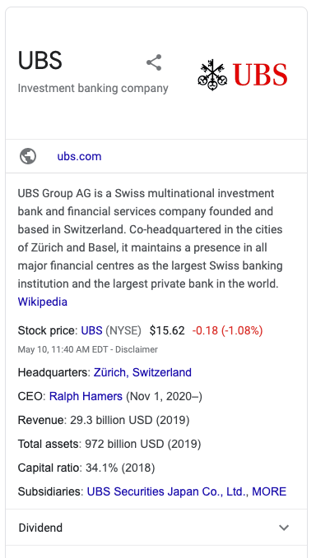This is an excerpt from the ebook The Rise of the Knowledge Graph. To learn more about knowledge graphs or semantic systems, download the full ebook.
The term knowledge graph came into vogue shortly after Google’s 2012 announcement of its new capabilities for managing data on a worldwide, connected scale. In contrast to earlier experiences with Google as a global index of documents, Google search results began to include relevant knowledge cards for almost any concept.

Figure 1. Example of a Google knowledge card
for UBS, a multinational bank.
Figure 1 shows one such card, for the international bank, UBS. These cards were linked to one another; the links to Ralph Hamers and Zurich, Switzerland, point to other, similar cards. The result is a graph of named entities, connected to one another with meaningful links. In addition to the cards, the graph included templates for describing the attributes collected on the cards. For example, all cards for publicly traded companies have the same structure (stock price, CEO, headquarters, etc.); these templates are called frames.
Google used this graph to provide insight during search and retrieval, making its results more relevant and providing additional interpretive context. This context took the form of direct links to closely associated information and services that could act directly on the information presented. For example, a map might be provided that pinpoints a location, generates driving directions, or presents the latest stock price. Frames are automatically associated with search results and bring with them unambiguously described data structures that are suitable input to associated services.
As executives desired to emulate the capabilities of Google in their own enterprises, the moniker “knowledge graph” was used to describe any distributed graph data and metadata system, based on the same principles of linking distributed, meaningful data entities and appropriate services in a graph structure.
The knowledge graphs that power Google’s knowledge cards have a pedigree going back to the early days of artificial intelligence research, where a number of systems were developed to allow machines to understand the meaning of data; we refer to these systems collectively as semantic systems.
The Rise of the Knowledge Graph ebook describes semantic systems, data representation, and how to knit it all together. For this blog post, we will move forward to answer the question, “Okay. But how do I do this with my own data?”
To accomplish this kind of (what seems easy) data visibility for a simple query, you must have data tied to knowledge representation. This means, you need to begin stitching together your data with a knowledge graph platform to create your data fabric. The data fabric being the metadata layer that ties your simple search query to all the common results a user would want surfaced, forming your very own knowledge card.
It’s this kind of problem solving that excites us at Cambridge Semantics, and it’s the enthusiasm thinking through the possibilities that propelled us to build Anzo.
Learn more about Anzo and how we can help you surface insights.
